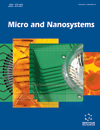- Home
- A-Z Publications
- Micro and Nanosystems
- Previous Issues
- Volume 5, Issue 2, 2013
Micro and Nanosystems - Volume 5, Issue 2, 2013
Volume 5, Issue 2, 2013
-
-
Cell Culture in Microfluidic Systems
More LessAuthors: Yung-Shin Sun and Ji-Yen ChengMicrofluidic systems provide powerful tools for controlling the in vitro cellular microenvironment which best mimick the in vivo biological matrix. Such devices have been applied to both temporal and spatial manipulation of cell growth and stimuli by micro-scaled channels, patterns, and fluidic systems, creating new opportunities for biologists to study cellular behaviors under different physical and chemical conditions. In this pa Read More
-
-
-
Impedance based Microfluidic Biosensor for Cell Study
More LessAuthors: Yang Mo, Ye Weiwei, Chan Chunyu, Shi Jingyu and Xiao LidanBiosensing fields have seen great advances in the past twenty years for cell study. Impedance based biosensor is one of the most important biosensors which can rapidly detect cellular behaviors in real time. The recent manufacturing development in micro-technology opens new horizons to develop microfluidic chip based impedance based biosensor as a real-time and label-free technique for a wide range of cellular studie Read More
-
-
-
Review: Applications of Fluorescence Correlation Spectroscopy with Microfluidic Devices
More LessBy Tim C. LeiFluorescence Correlation Spectroscopy (FCS) is a fluorescent spectroscopic technique that can be applied to measure the flow dynamics of a microfluidic channel. The principle of FCS is fluorescent molecules traveling through a tightly focused light volume inside a fluidic channel causes the fluorescent signal to fluctuate as the fluorescent molecules enter and exit the laser light focus. The flow parameter of the fluidic cha Read More
-
-
-
Evaluation of Pectin as a Material for Hepatocyte Encapsulation
More LessAuthors: Shiao-Wen Tsai and Hau-Min LiouOver the past several decades, many in vitro three-dimensional hepatocyte culture systems have been established, including collagen sandwiches, Matrigel™ cultures and microencapsulation systems. In addition, several studies have shown that materials with galactose ligands conjugated to their surfaces can improve hepatocyte attachment and allow the cells to maintain most of their functions. Pectin is a heterogeneous pol Read More
-
-
-
Effects of Surface Morphology Variation on the Degradation Rate of Poly(L-Lactic Acid) Membranes and the Behavior of Attached Cells
More LessBy I-Chi LeeTo study the effect of membrane morphology variation on biodegradation and the behavior of adhering cells, three types of poly(L–lactic acid) (PLLA) membranes with different morphologies—particulate, porous, and dense—were prepared. Degradation of the PLLA membranes was performed at 37°C in hydrogen peroxide solution to accelerate degradation. In addition, these degradation curves were compared with Read More
-
-
-
Application in Electrochemistry of Graphene-Modified Electrodes
More LessAuthors: Maria Coros, Florina Pogacean, Alexandru R. Biris, Alexandru S. Biris and Stela PruneanuDue to its unique physicochemical properties, graphene has received increasing attention. This article selectively reviews the application of graphene for direct electrochemistry of enzymes, small biomolecules, DNA sensing, and environmental analysis. Graphene oxide (GO) and reduced graphene oxide (RGO) have been used as sensors for gases and heavy metal ions. In all cases, the sensors performed well, proving to b Read More
-
-
-
Review of Graphene-Supported Metal Nanoparticles as New and Efficient Heterogeneous Catalysts
More LessAuthors: Gabriela Blanita and Mihaela D. LazarGraphene (Gr) is considered to be an ideal, two-dimensional catalytic support, due to its excellent electrical and thermal conductivity, mechanical strength and high surface area. In this paper we review recent progress in graphene applications as a catalyst support for graphene-supported metal nanoparticle heterogeneous catalysts, MeNP/Gr. For each catalyst the preparation method is described, and also the most signific Read More
-
-
-
Overview of Nanotechnology Applications in Construction Industry in the United States
More LessNanotechnology, defined as the science of very small matter called nanomaterial, comprises the study of chemical and physical properties of particles which are structured in sizes ranging from 1 to 100 nanometers. At this size range, nanomaterial exhibits superior chemical and physical characteristics as compared to those displayed while existing in normal size. To date, multiple nanotechnology research centers within t Read More
-
Most Read This Month
Article
content/journals/mns
Journal
10
5
false
en


